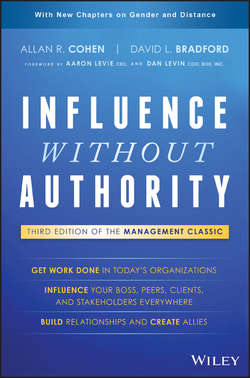Читать книгу Influence Without Authority - Cohen Allan R. - Страница 18
На сайте Литреса книга снята с продажи.
PART II
THE INFLUENCE MODEL
CHAPTER 2
THE INFLUENCE MODEL: TRADING WHAT THEY WANT FOR WHAT YOU'VE GOT (USING RECIPROCITY AND EXCHANGE)
Self-Created Barriers to Influencing
ОглавлениеWe have described a straightforward model for diagnosing what to do and executing it to achieve influence. Over the years, we have taught many people to use this model successfully. But we have also observed many failed efforts at each stage of the model, whether or not the person was aware of using it. Either the person desiring influence manages to make things worse, gives up prematurely, or doesn't even try out of frustration from anticipated failure. Before subsequent chapters explain how to use the important parts of the model, here are the most common ways that people block their own effectiveness at each stage. Table 2.3 can serve as warnings to monitor yourself when trying to make things happen.
Table 2.3 Common Self-Created Barriers to Influencing
Barrier: Not Assuming the Other Person Is at Least a Potential Ally
Failure to think positively about people who are difficult to influence is perhaps the deadliest self-created trap. It usually starts when a request is turned down. You want something clearly important to you that the other person can deliver. Sometimes you follow this with a second request and, if you are really determined, a third. Few people can be turned down two to three times without becoming convinced that something is fundamentally wrong with the other person. (Psychologists call this attribution.)8 The person has a defect of character, motives, or intelligence, or is a “perfect representative of that miserable group of incompetents from (the offending group).” Even when the negative attribution isn't spoken out loud (“Just another empty suit from marketing.” “Another engineering nerd.” “A numbers-obsessed shark from finance.” “A soft-headed bleeding heart from HR.” “A green eyeshade accountant who doesn't have the personality to be an actuary.”), it gets communicated.
Конец ознакомительного фрагмента. Купить книгу
8
We use our version of attribution theory throughout the book. The theory was reported in H. H. Kelley, Attribution in Social Interaction (Morristown, NJ: General Learning Press, 1971) and F. Heider, The Psychology of Interpersonal Relations (New York: John Wiley & Sons, 1958).
